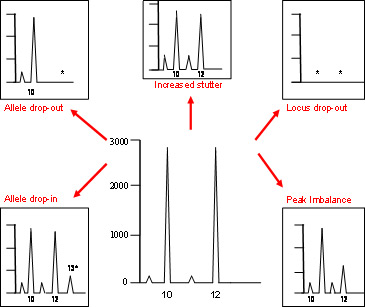Aviso de archivo
Esta es una página de archivo que ya no se actualiza. Puede contener información desactualizada y es posible que los enlaces ya no funcionen como se pretendía originalmente.
Home | Glossary | Resources | Help | Contact Us | Course Map
Due to the kinetics of the PCR (Polymerase Chain Reaction) process, a small number of starting genomic DNA templates will result in the production of stochastic sampling artifacts.17 Thus the bimolecular reaction comprising a primer binding to its cognate template will be a random and rare event in the LCN (Low Copy Number) milieu, in which only a few target templates are available. Specifically, the molecular collisions required may or may not occur for each allele during each of the first few cycles, resulting in a significant imbalance between alleles or, in extreme cases, total loss of one or both alleles.19 Only those alleles that are amplified efficiently during the first few cycles will be able to produce sufficient product to surpass the detection threshold of the standard PCR endpoint analysis.
Depending upon the sample and the particular amplification, stochastically induced allelic imbalance and dropout of one or both alleles will be commonly observed in LCN profiles (see figure below). Stutter peak height ratios are also raised in some LCN samples. All of these factors are significantly problematic for mixture interpretation which is why this technique is not commonly used with traditional casework mixture samples.
Contamination and Spurious Alleles
The increase in sensitivity of LCN analysis permits the detection of low levels of extraneous DNA contamination that, while often present, is not normally seen with standard 28 cycle STR (Short Tandem Repeats) analysis.17 Thus alleles may show up in the profile that do not originate from the principal DNA donor(s) (see figure) and, in control experiments, have been shown to occur with known single donor samples. Such allelic drop-in is more-often-than-not of unknown origin but could be due to DNA from a variety of intralaboratory sources, including consumable items and personnel. As a result, LCN analysis should only be conducted in sterile laboratory facilities that have in place suitable engineering controls, akin to those employed for mtDNA analysis. This factor, too, is significantly problematic for mixture analysis and factors into the decisions of most laboratories not to use this technique on traditional casework mixture samples.
Read more about contamination in course: DNA Amplification for Forensic Analysts.
Additional Online Courses
- What Every First Responding Officer Should Know About DNA Evidence
- Collecting DNA Evidence at Property Crime Scenes
- DNA – A Prosecutor’s Practice Notebook
- Crime Scene and DNA Basics
- Laboratory Safety Programs
- DNA Amplification
- Population Genetics and Statistics
- Non-STR DNA Markers: SNPs, Y-STRs, LCN and mtDNA
- Firearms Examiner Training
- Forensic DNA Education for Law Enforcement Decisionmakers
- What Every Investigator and Evidence Technician Should Know About DNA Evidence
- Principles of Forensic DNA for Officers of the Court
- Law 101: Legal Guide for the Forensic Expert
- Laboratory Orientation and Testing of Body Fluids and Tissues
- DNA Extraction and Quantitation
- STR Data Analysis and Interpretation
- Communication Skills, Report Writing, and Courtroom Testimony
- Español for Law Enforcement
- Amplified DNA Product Separation for Forensic Analysts


